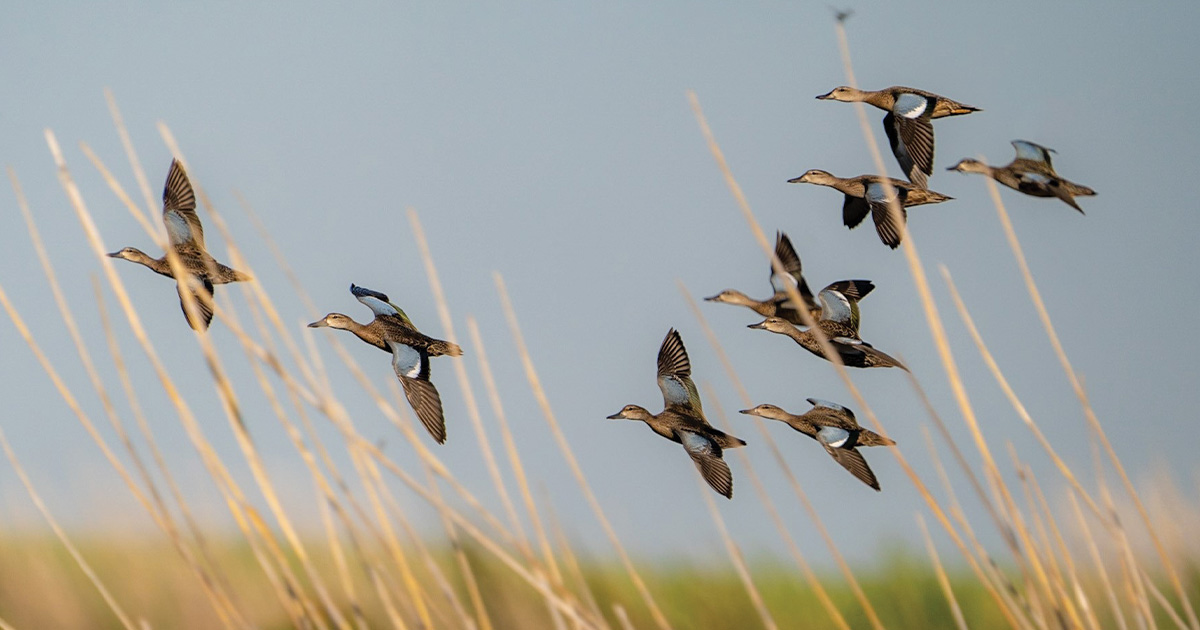Migration Alert: Impressive Teal Numbers Reported Along the Texas Coast
Sept. 16, 2025 – Central Flyway – South Texas
Sept. 16, 2025 – Central Flyway – South Texas

How do coastal duck hunters occupy their time and mental energy when Texas is overflowing with blue-winged teal, and the season doesn’t begin for another week? Pray nothing changes.
Last year at this time, Texans were enjoying the first few days of the traditional 16-day special teal season that has been a harbinger of September for over the past two decades. Yet, with blue-winged teal numbers dipping slightly below the 4.5 million population threshold mandated to warrant the 16-day affair, Lone Star teal hunters are priming for a 9-day season.
Fall-like temperatures in early September and a full moon have Texas coastal prairies and marshes buzzing with bluewings.
“We’ve been holding way too many birds, way too early,” Ross Russell of El Campo says. “There have been large groups of teal here since the last week of August and many more have arrived with the full moon.”
Seasoned duck hunters know that teal season is a “here today, gone tomorrow” kind of affair. Migrating blue-winged teal are the first ducks to arrive in the fall, and the first ducks to leave as well.
“Bird numbers look good at this point, but time will tell if weather conditions push these birds out prior to the opener,” Russell says. “Historically, the last seven or eight days of September are a grind for teal hunting. So, with the season running the last two weekends of September, I really don’t know what to expect.”
Rice farmer, hunter, and DU volunteer, Slade Schiurring of El Campo reports that teal numbers and habitat conditions on the prairies look promising.
“We’re holding lots of birds on all of our ponds across our farms west of El Campo,” he says. “Solid numbers are in our moist-soil ponds as well as second-cropped rice. Lots of water and conventional rice are concentrating birds in our areas of the western rice belt.”
It has been a wet summer for many regions along the coast of Texas; however, there have been pockets of coastal counties that remain dry, which has birds concentrated in moist-soil units that were able to collect that “free water.”
“Whatever body of water you can find, hunt it,” Fletcher Feldman, a guide with Run-N-Gun Adventures in Bay City says. “This last cool front brought the first real big bulk of birds down and our ponds around the county went from a few small groups to big huntable numbers. The prairie is holding good numbers, but now we are seeing our coastal stuff come alive.”
Coastal marsh hunters should benefit from a wet summer with runoff from soaking rains balancing the brine and encouraging aquatic vegetation to prosper. When duck foods like wigeongrass and southern naiad blossom in brackish marshes, duck hunting success improves drastically.
The Chambers and Jefferson County marshes east of Houston, historical waterfowl hubs for centuries, expect to enjoy fast shoots as well.
“With all the rain this summer, habitat conditions are excellent in the marsh,” reports Brian Davenport, a guide with Fin and Fowl Outfitters near Anahuac. “There is tons of wigeongrass and other aquatics, and I think the marsh will come into play with the short season and more hunting pressure.”
Teal season runs Sept. 20 to 28, with a daily bag limit of six per hunter, per day.
“Rice fields on the east side are holding big numbers of teal, and a big push of birds have shown with the full moon last week,” Davenport adds. “I think we are in for a fast and furious nine days.”
Stay up to date with the latest migration information.
Ducks Unlimited uses cookies to enhance your browsing experience, optimize site functionality, analyze traffic, and deliver personalized advertising through third parties. By continuing to use this site, you agree to our use of cookies. View Privacy Policy